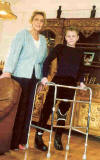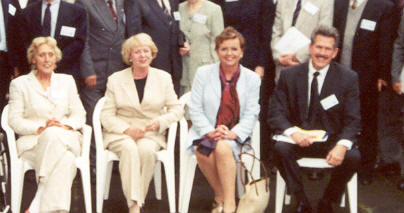Historically, SCI has been one of mankind’s most
devastating disorders. The ancient Edwin Smith Surgical Papyrus written in
Egyptian hieroglyphics states that SCI is an ailment not to be cured, a
view that has prevailed for 5,000 years - until recently. For the first
time in mankind’s history, there is shift in our consciousness about what
is possible after injury. Patients once resigned to the defeating
you-will-never-walk-again attitude that is deeply imprinted in
consciousness after injury are becoming more and more convinced that some
functional recovery truly may be possible. Given the lessons of history
for other disorders and diseases, this shift by itself will greatly
accelerate the development of SCI therapies.
Background: Chaos theory postulates that a flap of a
butterfly wing can initiate a disturbance that ultimately leads to a
hurricane across the world. In this cas e, the butterfly wing’s flap was
the severe injury in a 1989 auto accident of Hrafnhildur “Bido” Thoroddsen,
the 17-year old daughter of Auður Guðjónsdóttir. Although an individual
tragedy, Bido’s injury initiated a cascade of events that could
significantly affect SCI globally.
e, the butterfly wing’s flap was
the severe injury in a 1989 auto accident of Hrafnhildur “Bido” Thoroddsen,
the 17-year old daughter of Auður Guðjónsdóttir. Although an individual
tragedy, Bido’s injury initiated a cascade of events that could
significantly affect SCI globally.
As featured in the Icelandic documentary You Will
Never Walk Again, Guðjónsdóttir initiated a world-wide search for
therapies that could help her daughter. Her struggle became the seed that
germinated into her desire to create an informational resource that could
help others who sustain such a devastating injury. Due to her ongoing SCI
advocacy efforts, she was selected as 2001 Icelandic Woman of the Year.
Guðjónsdóttir’s search eventually led to Dr.
Shaocheng Zhang, a Chinese surgeon who, as discussed elsewhere,
surgically links a nerve above the injury site to a nerve below the injury
site, creating a new functional connection between the brain and
previously paralyzed areas. However, in the mid-1990s, it was politically
difficult for Zhang to travel to Iceland to perform the surgery, and Bido
was not healthy enough to travel to China. It took the intercession of
Iceland’s President Vigdis Finnbogadottir with the Chinese leadership to
obtain permission for Zhang to travel to Iceland. Zhang’s surgery helped
Bido regain substantial, life-enhancing function.
As Guðjónsdóttir expertise grew, she started the
planning for an international SCI conference. In addition to Icelandic
health officials, her efforts were aided by 1) the now SCI-sensitized
President Vigdis Finnbogadottir a nd
2) Lara Margaret Ragnarsdottir, a member of Iceland’s Althingi/Parliament,
the country’s representative to the Council of Europe (COE). In addition, the
WHO agreed to cosponsor the conference. (Photo: Audur
Gudjonsdottir, Former President Vigdis Finnbogadottir, Althingi Member Lara
Margaret Ragnarsdottir, and Report Author Laurance Johnston at 2001 SCI
Reykjavik Conference).
nd
2) Lara Margaret Ragnarsdottir, a member of Iceland’s Althingi/Parliament,
the country’s representative to the Council of Europe (COE). In addition, the
WHO agreed to cosponsor the conference. (Photo: Audur
Gudjonsdottir, Former President Vigdis Finnbogadottir, Althingi Member Lara
Margaret Ragnarsdottir, and Report Author Laurance Johnston at 2001 SCI
Reykjavik Conference).
The overall goal of this conference
held in Reykjavik, Iceland, June 1-2, 2001 was to catalyze the development
of new paradigms to address SCI. As such a diversity of perspectives was
brought in, ranging from state-of-the-art stem-cell biology to the ancient
wisdom of Eastern Medicine.
As emphasized in her Foreword, President Finnbogadottir opened the meeting with a
discussion of SCI as a human-rights issue. She emphasized that medical
research is one mechanism by which people with SCI can be meaningfully
integrated into society and enjoy mankind’s most fundamental freedom of
self-determination. She noted that our efforts should not be viewed as
making one whole again because the spirit is always whole. The goal is
empowerment, freedom of self-determination, and the ability to manifest
the spirit within.
In a letter dated December 12, 2001 (Appendix 4), WHO
Director General Dr. Gro Harlem Brundtland declared a willingness to take
part in establishing
a WHO Collaborating Center on Human SCI to be located in Reykjavik.
This letter stated: “The Collaborating Center will support
WHO global activities. The terms of reference will be the establishment of
a database and to act as a focal point for international research on
spinal cord injury.”
In addition, Ms. Ragnarsdottir spearheaded the
development of a COE report (doc. 9401) recommending: “… that a world
center for the coordination of research and development concerning spinal
cord injuries should be established with the World Health Organization …
together with a research database that would pool all existing and future
medical and scientific material on spinal cord injuries and ensure
effective co-operation between doctors and researchers from all over the
world.”
A draft mission statement for the
Collaborating Center is provided in Appendix 5.
Conclusion: By supporting this vision of the future, Iceland is
catalyzing its creation. Because this effort has the potential to help so
many throughout the world yet relatively few of its own citizens, it
represents a standard by which a society is judged. Instead of force that
is so commonly used in today’s world of geopolitical self interest,
Iceland is employing power, whose impact will be much more enduring.
Overall, in recent decades, there has been tremendous
progress in our understanding of traumatic spinal cord injury, an
understanding that is beginning to be transformed into real-world
therapies. Although this disorder was once considered so intractable that
its repair was described as the Holy Grail of neurological research, this
Grail is now within our grasp.
A decade ago, the author of this report attended a US
Congressional hearing focused on SCI. At this hearing, a colleague with
high-level quadriplegia characterized SCI research by paraphrasing a
famous Martin Luther King speech. He believed that after a long trek in
the wilderness, we have climbed the mountain and for the first time can
see in the distance the Promised Land of restored function, of which some
may complete the journey and some may not.
Times have changed. This is no longer a mere vision
hovering on the horizon. With groundbreaking scientists and clinicians
guiding the way, the first pioneers with SCI are beginning to step, in
some cases literally, into this Promised Land. It is not false hope but a
growing reality coalescing in bits and pieces. Through creating this
nascent SCI-Collaborating Center, the people of Iceland are helping to
create a fast-lane to this Promised Land.
TOP